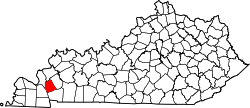Confederate, Kentucky | |
|---|---|
| Coordinates: 36°59′31″N87°59′51″W / 36.99194°N 87.99750°W | |
| Country | United States |
| State | Kentucky |
| County | Lyon |
| Elevation | 584 ft (178 m) |
| Time zone | UTC-6 (Central (CST)) |
| • Summer (DST) | UTC-5 (CST) |
| GNIS feature ID | 507743 [1] |
Confederate is an unincorporated community in Lyon County, Kentucky, United States.


